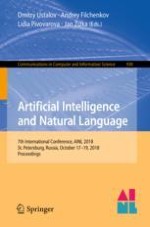2018 | OriginalPaper | Chapter
Named Entity Recognition in Russian with Word Representation Learned by a Bidirectional Language Model
Authors : Georgy Konoplich, Evgeniy Putin, Andrey Filchenkov, Roman Rybka
Published in: Artificial Intelligence and Natural Language
Publisher: Springer International Publishing
Activate our intelligent search to find suitable subject content or patents.
Select sections of text to find matching patents with Artificial Intelligence. powered by
Select sections of text to find additional relevant content using AI-assisted search. powered by
